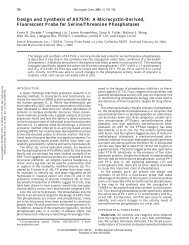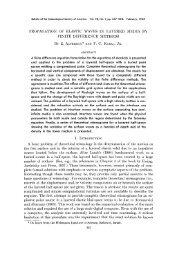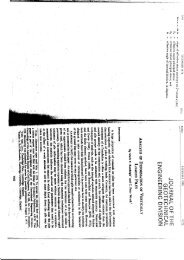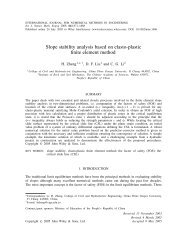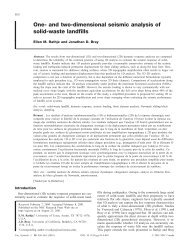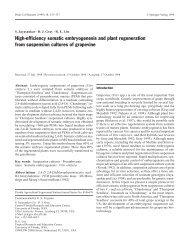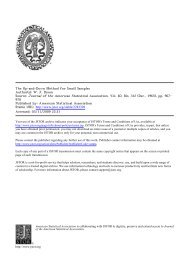Synthesis of large surface area LaFeO3 nanoparticles by SBA-16 ...
Synthesis of large surface area LaFeO3 nanoparticles by SBA-16 ...
Synthesis of large surface area LaFeO3 nanoparticles by SBA-16 ...
You also want an ePaper? Increase the reach of your titles
YUMPU automatically turns print PDFs into web optimized ePapers that Google loves.
J Nanopart Res<br />
photocatalysts for water splitting such as SrTiO 3 ,<br />
NaTaO 3 , etc. (Subramanian et al. 2006; Kato and Kudo<br />
2003; Maeda and Domen 2007; Penä and Fierro 2001),<br />
and the photocatalytic decompositions <strong>of</strong> organic<br />
compounds have been widely studied, but all the<br />
performance need to be advanced.<br />
The specific <strong>surface</strong> <strong>area</strong> and crystal structure are<br />
the most important two factors influencing catalytic<br />
activity. During several conventional synthetic processes<br />
<strong>of</strong> perovskites, such as citrate method and<br />
solid state reactions, the high-temperature thermal<br />
treatments needed usually lead to the sintering <strong>of</strong> the<br />
resulting particles, consequently decreasing greatly<br />
the specific <strong>surface</strong> <strong>area</strong>, which will <strong>large</strong>ly influence<br />
the performance <strong>of</strong> the resulting perovskites and<br />
hinder their widespread use as catalysts. Thus, novel<br />
synthetic methods to obtain materials with <strong>large</strong><br />
specific <strong>surface</strong> <strong>area</strong> are greatly desired.<br />
Among various preparation methods <strong>of</strong> nanosized<br />
materials, the template method, which provides a<br />
good choice for the synthesis <strong>of</strong> <strong>nanoparticles</strong> with<br />
controllable size and shape because <strong>of</strong> being in a<br />
confined three-dimensional (3D) space, has recently<br />
sparked great research interests (Lu and Schüth 2006;<br />
Schüth 2003). Unlike conventional surfactant templates,<br />
the hard template could effectively maintain<br />
the local strain caused <strong>by</strong> the crystallization <strong>of</strong><br />
precursors. Zhao et al. synthesized highly dispersed<br />
TiO 2 <strong>nanoparticles</strong> using <strong>SBA</strong>-15 as hard template<br />
(Zhao and Yu 2006). Valdés-Solís et al. prepared<br />
nanosized perovskites and spinels through a silica<br />
xerogel template route (Valdés-Solís et al. 2005).<br />
However, so far the articles on the use <strong>of</strong> the <strong>SBA</strong>-<strong>16</strong><br />
as hard template to synthesize nanosized solid<br />
materials are seldom reported. <strong>SBA</strong>-<strong>16</strong> is a kind <strong>of</strong><br />
3D, ‘‘cage-like’’ mesoporous silica, and its pores are<br />
connected <strong>by</strong> some mesoporous windows, so as to be<br />
beneficial for the substance transportation. Thus, it<br />
can be deduced that its negative replica is 3D<br />
connected structure (Shi et al. 2005a, b; Schüth and<br />
Schmid 2002; Kärger and Freude 2002), so that the<br />
<strong>SBA</strong>-<strong>16</strong> as template to prepare porous solid materials<br />
with <strong>large</strong> <strong>surface</strong> <strong>area</strong> is feasible. It has been<br />
demonstrated that mesoporous structure is highly<br />
desirable for effective photocatalysis, since such<br />
structures enable more light to be harvested and also<br />
possess continuous pore channels that facilitate the<br />
transfer <strong>of</strong> reactant molecules.<br />
As a kind <strong>of</strong> important functional material, LaFeO 3<br />
with a typical ABO 3 -type perovskite structure has<br />
many applications, such as catalytic oxidation, electrode<br />
materials, and chemical sensors for the humidity<br />
and alcohols, and it also is an ideal potential semiconductor<br />
material for visible photocatalyst because <strong>of</strong> its<br />
small band gap energy (Wang et al. 2006; Li et al.<br />
2007). Herein, nanosized LaFeO 3 with <strong>large</strong> <strong>surface</strong><br />
<strong>area</strong> was synthesized with mesoporous silica <strong>SBA</strong>-<strong>16</strong><br />
as hard template for the first time. The as-prepared<br />
LaFeO 3 exhibits excellent visible-light photocatalytic<br />
activity, which is attributed to the <strong>large</strong> <strong>surface</strong> <strong>area</strong>, as<br />
well as to the high photoinduced charge separation rate<br />
mainly based on the SPS responses. This should be<br />
valuable for the practical application <strong>of</strong> LaFeO 3 and<br />
also provides a new strategy to prepare other highperformance<br />
nanostructured oxide composite materials<br />
with <strong>large</strong> <strong>surface</strong> <strong>area</strong>.<br />
Experimental<br />
Preparation <strong>of</strong> the template <strong>SBA</strong>-<strong>16</strong><br />
The <strong>SBA</strong>-<strong>16</strong> was synthesized <strong>by</strong> a sol–gel process as<br />
described elsewhere (Shi et al. 2005a, b). The F127<br />
(EO 106 PO 70 EO 106 , BASF) and Ethyl silicate<br />
(C 8 H 20 O 4 Si) were used as surfactant and silicon<br />
sources, respectively. After the resulting xerogel was<br />
calcined at 550 °C with a heating rate <strong>of</strong> 1 °C min -1<br />
and ground, the mesoporous silica <strong>SBA</strong>-<strong>16</strong> was<br />
obtained eventually.<br />
<strong>Synthesis</strong> <strong>of</strong> the samples<br />
Nanosized LaFeO 3 was synthesized according to the<br />
flowchart shown in Fig. 1. First, 1 g <strong>of</strong> freshly<br />
as-synthesized <strong>SBA</strong>-<strong>16</strong> was dispersed in 2 mL <strong>of</strong><br />
ethanol solution, containing 0.0041 mol <strong>of</strong> La(NO 3 ) 3 <br />
6H 2 O and 0.0041 mol <strong>of</strong> Fe(NO 3 ) 3 9H 2 O. After<br />
ultrasonication for 10 min, the mixture obtained was<br />
kept at 60 °C under stirring until the solvent was<br />
evaporated completely. Subsequently, the LaFeO 3 –<br />
<strong>SBA</strong>-<strong>16</strong> composite was obtained after the above<br />
mixture was dried in a vacuum at 80 °C and calcined<br />
in air at needed temperature for 2 h. Finally, the<br />
template-free LaFeO 3 nanopowder was gained <strong>by</strong><br />
washing, drying, grinding, and heat-treatment at<br />
123



